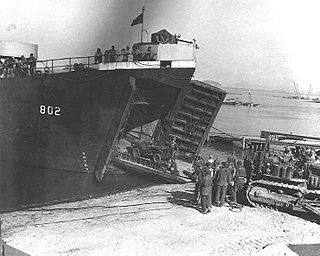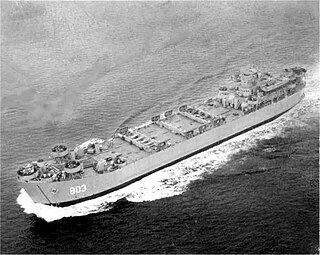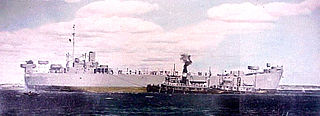
USS Mahoning County (LST-914) was an LST-542-class tank landing ship built for the United States Navy during World War II. Like many of her class, she was not named and is properly referred to by her hull designation. She was later named after Mahoning County, Ohio, she was the only US Naval vessel to bear the name.

USS Marion County (LST-975) was an LST-542-class tank landing ship built for the United States Navy during World War II. Like many of her class, she was not named and is properly referred to by her hull designation. She was later named after counties in seventeen U.S. states, she was the only US Naval vessel to bear the name.

USS Orange County (LST–1068) was an LST-542-class tank landing ship built for the United States Navy during World War II. Unlike many of her class, which received only numbers and were disposed of after World War II, she survived long enough to be named. On 1 July 1955, all LSTs still in commission were named for US counties or parishes; LST-1068 was given the name Orange County, for counties in the states of California, Florida, Indiana, New York, North Carolina, Texas, Vermont, and Virginia, she was the only US Naval vessel to bear the name.

USS LST-209 was an LST-1-class tank landing ship built for the United States Navy during World War II. Like most of the ships of her class, she was not originally named, and known only by her designation. From June to August 1951 she served a stint as a part of the Military Sea Transportation Service (MSTS), manned by a civilian crew, and renamed USNS T-LST-209. She was recommissioned under her original name 24 August 1951, and renamed USS Bamberg County (LST-209) on 1 July 1955. She was named for Bamberg County, South Carolina, the only U.S. Naval vessel to bear the name.

USS Menelaus (ARL-13) was laid down as a United States Navy LST-542-class tank landing ship but converted to one of 39 Achelous-class repair ships that were used for repairing landing craft during World War II. Named for Menelaus, she was the only US Naval vessel to bear the name.

USS Sphinx (ARL-24) was laid down as a United States Navy LST-542-class tank landing ship but converted to one of 39 Achelous-class repair ships that were used for repairing landing craft during World War II. Named for the Sphinx, she was the only US Naval vessel to bear the name.

USS Romulus (ARL-22) was laid down as a United States Navy LST-542-class tank landing ship but converted to one of 39 Achelous-class repair ships that were used for repairing landing craft during World War II. Named for Romulus, she was the only US Naval vessel to bear the name.

USS New London County (LST-1066) was an LST-542-class tank landing ship in the United States Navy. Unlike many of her class, which received only numbers and were disposed of after World War II, she survived long enough to be named. On 1 July 1955, all LSTs still in commission were named for US counties or parishes; LST-1066 was given the name New London County, after the county in Connecticut.

USS Maricopa County (LST-938) was an LST-542-class tank landing ship built for the United States Navy during World War II. Like many of her class, she was not named and is properly referred to by her hull designation. She was later named after Maricopa County, Arizona, she was the only US Naval vessel to bear the name.
USS Park County (LST-1077) was an LST-542-class tank landing ship in the United States Navy. Unlike many of her class, which received only numbers and were disposed of after World War II, she survived long enough to be named. On 1 July 1955, all LSTs still in commission were named for US counties or parishes; LST-1077 was given the name Park County, after a counties in Colorado, Montana, and Wyoming.

USS Hamilton County (LST-802) was an LST-542-class tank landing ship built for the United States Navy during World War II. Named after counties in Florida, Illinois, Indiana, Iowa, Kansas, Nebraska, New York, Ohio, Tennessee, and Texas, she was the only U.S. Naval vessel to bear the name.

The USS Hampden County (LST-803) was an LST-542-class tank landing ship built for the United States Navy during World War II. Named after Hampden County, Massachusetts, she was the only U.S. Naval vessel to bear the name.

USS Lake County (LST-880) was an LST-542-class tank landing ship built for the United States Navy during World War II. Named after counties in twelve U.S. states, she was the only U.S. Naval vessel to bear the name.
USS LST-888 was an LST-542-class tank landing ship built for the United States Navy during World War II. Late in her career she was renamed Lee County (LST-888) – after counties in twelve Southern and Midwestern states, the only U.S. Naval vessel to bear that name – but saw no active service under that name.

USS Mahnomen County (LST-912) was an LST-542-class tank landing ship built for the United States Navy during World War II. Like many of her class, she was not named and is properly referred to by her hull designation. She was later named after Mahnomen County, Minnesota, and was the only US Navy vessel to bear the name.

USS Marinette County (LST-953) was an LST-542-class tank landing ship built for the United States Navy during World War II. Like many of her class, she was not named and is properly referred to by her hull designation. She was later named after Marinette County, Wisconsin, she was the only US Naval vessel to bear the name.
USS Ouachita County (LST-1071) was an LST-542-class tank landing ship built for the United States Navy during World War II. Named for Ouachita County, Arkansas, she was the only U.S. Naval vessel to bear the name.
USS Skimmer (AMCU-41/LCIL-1093) was an LCI(L)-351-class landing craft infantry built for the U.S. Navy for the task of landing troops in combat areas.
USS Proton (AG-147/AKS-28) -- also known as USS LST-1078 – was an LST-542-class tank landing ship launched by the U.S. Navy during the final months of World War II. Proton served as a troop ship, a cargo ship and as an electronic parts supply ship for the U.S. Pacific Fleet and was decommissioned following the Korean War.
USS LST-1079 was an LST-542-class tank landing ship in the United States Navy. Unlike many of her class, which received only numbers and were disposed of after World War II, she survived long enough to be named. On 1 July 1955, all LSTs still in commission were named for US counties or parishes; LST-1079 was given the name Payette County, after the county in Idaho.














